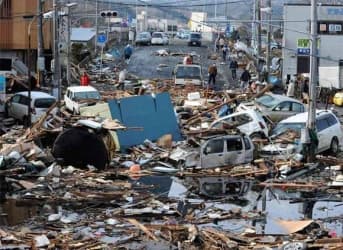As the world prepares to commemorate next week the first anniversary of the Fukushima nuclear disaster, Japanese scientists are warning that Tokyo is in increasing danger from a potential massive earthquake.
Greater Tokyo, with its 35 million inhabitants, has experienced a three-fold increase in tectonic activity in the year since the 9.0 Richter scale sub sea earthquake produced the tsunami that devastated Fukushima. Metropolitan Tokyo now averages 1.5 quakes in and around the city each day.
Tokyo has had many experiences with earthquakes. The 1923 Kanto earthquake was the most destructive of modern times, killing an estimated 140,000 people.
The earthquake that destroyed the Fukushima Daiichi nuclear power complex was the fifth largest ever recorded, originating below the sea about 40 miles off the Japanese coast. With a magnitude of 9.1 on the Richter Scale, the Great Tohoku earthquake shifted Honshu Island 8 feet to the east and made the Earth wobble on its axis. In its aftermath it sent a series of tsunamis, some 130 feet high, crashing into Japan’s eastern coast, reaching up to six miles inland and effectively destroying the Fukushima nuclear power plant. More than 15,000 people were killed and thousands remain missing today.
The government's Japan Agency for Marine-Earth Science and Technology ran a simulation of an earthquake with a magnitude of 7.3 occurring in the northern part of Tokyo Bay on a weekday evening. An estimated 6,400 people would die, with 160,000 injured, overwhelming the capital’s health services. Approximately 471,000 homes and buildings would be destroyed, most of them by fires, or because of liquefaction, a process where reclaimed land turns to mush.
So, what are the chances of Tokyo suffering a major quake?
The University of Tokyo's Earthquake Research Institute reports that Tokyo, built at the intersection of four tectonic plates, has a 50 percent chance of suffering a major earthquake measuring 7.0 or higher on the Richter Scale in the next four years.
Japan Agency for Marine-Earth Science and Technology executive director Asahiko Taira said simply, "We must prepare for the earthquake that will happen."
We now know more about the immediate aftermath of the destruction of the Fukushima Daiichi nuclear power complex. Last month the Rebuild Japan Initiative Foundation independent task force released the summary of the final chapter of its 400-page report, “Investigation on the Fukushima Daiichi Nuclear Accident” in “The Bulletin of Atomic Scientists,” with the full report scheduled for release later this month.
Entitled “Fukushima in review: A complex disaster, a disastrous response,” the chapter pulls no punches. The report paints an alarming picture of an almost total breakdown in communications between Prime Minister Naoto Kan’s government and the Tokyo Electric Power Corporation, owners and operators of the Fukushima Daiichi complex.
But the most alarming revelation in the report is that the government at one point considered evacuating Tokyo. It quotes Chief Cabinet Secretary Yukio Edano as warning that such a “demonic chain reaction” of plant meltdowns could result in the evacuation of Tokyo, 150 miles to the south. “We would lose Fukushima Daini, then we would lose Tokai,” Edano said, naming two other nearby nuclear plants. “If that happened, it was only logical to conclude that we would also lose Tokyo itself.”
So, what has the government done to prepare for the “big one” and its possible effects on other Japanese NPPs?
Beyond keeping its fingers crossed, not much.
But American citizens have been learning from Fukushima’s travails. Among other energy havoc wreaked by the tsunami, two oil refineries caught fire and burned for days, while fuel shortages hindered emergency response teams.
Oregon's Emergency Management Office hazards coordinator Althea Rizzo said that his agency is planning is under way for a major quake and tsunami as powerful as those of 2011, with his team expecting the Pacific Northwest to be in similar shape or worse if the "Big One" hits. Rizzo observed, "From the refinery to the gas tank there's all sorts of points along that way that are going to be prone to failure. The gasoline that you have in your car is probably going to be the gasoline you'll have for the next two to three months." State agencies are prodding energy suppliers to assess their vulnerability to an earthquake of up to magnitude 9 on the Richter Scale and to use that information to get started on the necessary structural or equipment upgrades to withstand such an onslaught.
Farther south, anti-nuclear campaigners are drawing parallels between the Fukushima and a pair of nuclear power plants on the California coast citing parallels of the similar ages of the reactors and their locations facing the ocean on active earthquake faults. The plant operators insist their facilities are safe and that California needs the energy. They according are circulating petitions, hoping to bring the future of shutting down the nuclear power plants by collecting 504,760 registered voter signatures for the California Nuclear Initiative petition to be placed on the ballot for the 2012 general election.
ADVERTISEMENT
It is overdue for Japan to consider mothballing its entire nuclear energy power complex, painful and expensive as such an option might be. The estimated costs of cleaning up from a “big” Tokyo earthquake have been estimated at up to $1.45 trillion, around a third of Japan's GDP.
But then, expensive as it might be to shut down Japan’s NPPS, it could be a bargain compared rebuilding Tokyo, much less to the incipient lawsuits now trickling in over Fukushima. TEPCO is now hearing from the lawyers, as forty-two shareholders of Tokyo Electric Power are suing the operator of the crippled Fukushima nuclear plant seeking a record-breaking 5.5 trillion yen ($67.7 billion) compensation.
In light of the above, all Tokyo’s choices are bad. But if its fate is to be savaged by an earthquake, no doubt the survivors would be pleased not to be breathing in radionuclides from crippled NPPs.
By. John C.K. Daly of Oilprice.com


















